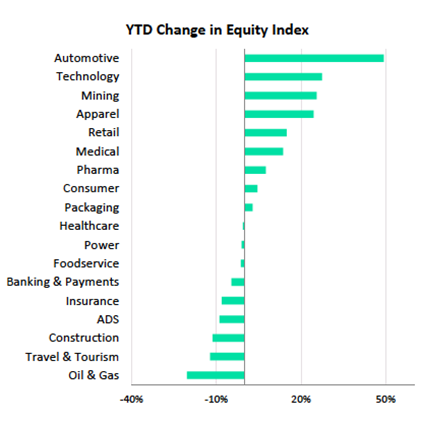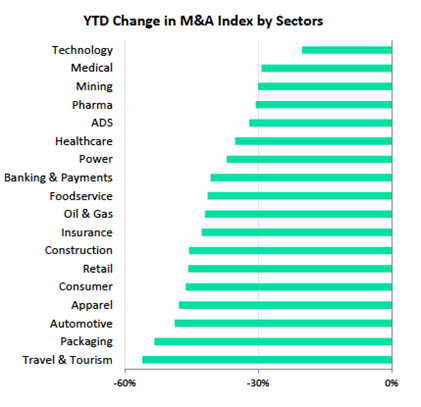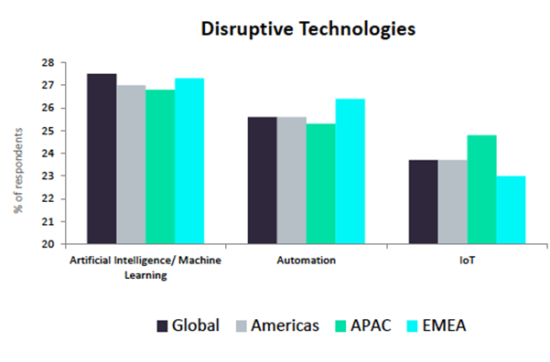Last July, when I wrote my blog New normal or new dawn?, I must have wished that, by 2021, we would be writing about COVID-19 in the past tense. Some scientists did warn us, but I am nevertheless a bit surprised to find myself still working from home, keeping social distance and wearing masks. How do others feel about that?
NetEvents, in partnership with research analysts GlobalData, have just released their inter@ctive CIO Round Table Predicting and Preparing for the New Normal – Achievving Growth Through Adversity. When they started planning their schedule, had they perhaps hoped for an end of crisis retrospective on business lessons learned? GlobalData’s Jeremiah Caron, who chaired the Round Table, said it all when he introduced his market data with “It is too early today to speak of the post COVID 19 market; rather, it is a matter of COVID 19 co-existence”.
Invited by Caron to join that Round Table, I can testify that, although the world is still very much in the grip of the crisis, a lot of very sound lessons are already being learned. I described the business world as entering its “Recovery” phase (not be confused with a “Recovered” phase, which would signify the “New Normal”).
Recovery marks the third phase of a sequence: React, Restore, Recover. My personal React Phase began last March when, like most of the business world, I simply had to start working from home. It was a reaction that offered no alternative, but it led towards my Restore phase. This was where I discovered that, yes, it is actually possible to continue business from home. To do that well required: moving business to the cloud, holding meetings online, boosting and securing connectivity and so on. At a personal level, the Restore phase also included my family experience of agreeing on priorities: allocating times and places, and learning to respect each family member’s needs.
Moving into the Recovery phase, we are now finding that some aspects forced onto us by that initial Reaction are actually working rather well. For 15 years I had been spending about 80% of my time “on the business road”, now I am spending so much more time with my family. That might have become an imposition on others, except that – because we are now all required to work from home – there is plenty of mutual recognition of the need for quiet times and un-cluttered spaces (even if the home wi-fi creaks a bit at times!)
As a father, I might have ben worrying that my children were embarking into a very different world than the one I had prepared them for. It is not that I think every student must now drop their chosen studies and switch to IT, but it will be increasingly necessary to be “tech savvy”. So, I am delighted to see my 15-year old daughter following online instructions to set up a security patch on her laptop by herself – without having to “run to Daddy” for help.
I am seeing several sectors that are also well into the Recovery phase. If someone waved a magic wand and banished COVID-19 overnight, we would not rush back to old ways. Home working started as a reaction, but many of our customers have already mandated a downsizing of central office space. Money that would have been spent on real estate is increasingly being channelled into digital transformation – and that is now a widespread global trend according to Jeremiah Caron. As Steve Berez, partner at Bain, pointed out during the NetEvents inter@ctive Round Table: digital transformation is no longer seen as a cost center, it has become a wise investment.
A clear example of such investment potential was presented in August 2020 when Tata Communications announced its Secure Connected Digital Experience’ (SCDx) solutions – expressly designed to help customers evolve from React through Restore towards Recover (into whatever new normal might emerge). SCDx offers three main benefits. The Secure Connected Digital Workplace enables employees – whether working from home, office or field – to co-operate seamlessly and securely while maintaining complete workplace readiness. For B2C businesses, our Digital Customer Experience Platform recreates their in-store experience online, enhanced by next generation commerce and video collaboration solutions for optimal customer engagement. Thirdly, we address the increasingly digital Supply Chain Ecosystem with secure access to core applications and better service to third parties.
All these aspects of collaboration are vital ingredients in our business, and in my case, collaboration has become almost contactless. Perhaps surprisingly, this has actually deepened the collaboration. Where a high-level meeting between busy senior players might have taken weeks to schedule and a flight half-way around the world – for no more than an hour or two – a virtual meeting can be fixed in a few days now. Not only are the conversations richer for that reduced formality, it is quicker and easy to follow them up to resolve any afterthoughts. Multiple companies have noted the increase in productivity from home working.
On the other hand, the ramping up period for product launches or new recruits has extended. Human contact is the most powerful teaching medium – schoolteachers along their students are also finding this under lockdown. A new employee learns so much from simply being in the physical work environment, absorbing impressions minute by minute. It can take so much longer to get up to speed in today’s virtual environment.
An event like the NetEvents December 16th Round Table is a great opportunity to compare notes with senior players from other companies and industries. What’s more, the initial analyst presentation provides a lot of understanding about what’s happening in the global context. The session has been very well reported by Scott Raynovich in a Forbes article Tech Experts Point To An Accelerated Drive To A Virtual ‘Omniverse’, so I will just add a few of mine own observations here.
Jeremiah Caron began with an interesting comparison between two different responses. The gap between the ‘haves’ – industries such as IT and communications that have flourished during the crisis – and the ‘have nots’ – industries such as live entertainment, insurance, construction and aviation – has already been well reported and is reflected in the annual changes in stock market valuations. One might have expected Automotive, Apparel and Retail shares to devalue in a year of economic shrinkage, but they have all done surprisingly well – Figure 1. His next slide showed the annual change in M&A volumes: a very different picture, one where every industry has been hit hard. The difference, he explained, was that M&A figures are “more an indication of what’s happening now… the mindset was in the moment – and that fell off the cliff.” Whereas stock valuations are more about future expectations – these have been surprisingly optimistic in several sectors – see Figure 2.
Figure 1: GlobalData IT Customer Insights Survey presented on the NetEvents CxO Roundtable Dec 16, 2020

Figure 2: GlobalData IT Customer Insights Survey presented on the NetEvents CxO Roundtable Dec 16, 2020

Figure 3: GlobalData IT Customer Insights Survey presented on the NetEvents CxO Roundtable Dec 16, 2020

Of particular interest to this discussion were the expectations for disruptive technologies – AI, Automation and IoT. Figure 3 shows responses to the question “what percentage of your budget is towards digital transformation?” Kevin Deierling, NVIDIA’s Head of Networking Business Unit, explained that, while digital transformation had already been massively accelerated by the pandemic: “a lot of companies think they are too late… in fact, we are right at the beginning of this transformation… the point here is that every single business has the potential to become an AI accelerated computing business. And it’s not late.”
Another potentially disruptive technology not quoted in Figure 3 is Virtual or Augmented Reality. Ron Abreu, Global IT Director of a manufacturing company, SWM International, explained that his company has invested heavily in virtual reality tools to enable folks to maintain training and factory skills even when they can’t come to a manufacturing site. This was a very interesting development in view of what I had said earlier about the way that contactless collaboration was slowing the ramping up of new recruitment and product launches. Abreu explained that: “Instead of sending engineers to [manufacturing] lines, we have created augmented reality training, using the Hololens glasses.” Hence the point taken up by Scott Raynovich in his Forbes article: the accelerating drive to a virtual omniverse.
Question time to the panel prompted a number of issues. One especially relevant to the enterprise was whether this massive shift to digital transformation might leave behind SMEs with smaller budgets. Steve Berez had already suggested that, whereas IT budgets were increasing overall, for many companies it was “more tactical spending around enabling remote work or increasing transaction capacity for digital transactions” rather than more strategic improvements. So, could the SMEs keep up?
Here the key factor was agility and, as Marvell Semiconductor CIO Adhir Mattu pointed out, migration to the cloud was not only a major saving for smaller businesses, it also further boosted their agility: “We have moved quite a bit of workload to the cloud… I’m envisioning in the next couple of years I don’t want any hardware on prem.” Steve Berez pointed out that, in addition to a flexible, agile technology architecture: “companies have an equal need for an agile, operating model or business system”. Here the relative agility of smaller companies, combined with collaboration and security solutions like SCDx, could indeed give them an advantage in a post-COVID economy.
To conclude this very rich discussion: at the start of 2021, most successful global enterprises stand somewhere between the Recover and Restore phases, but there is enough proof already that it is possible to achieve growth even through this present adversity. If you are not convinced, I certainly suggest that you should listen to this valuable Round Table yourself. The full recording of it is available here.
Transformational Hybrid SolutionsOur cloud-enablement services offer the best performance on your traffic-heavy websites or mission-critical applications.
Core NetworksTata Communications™ global IT infrastructure and fibre network delivers the resources you need, when and where you need them.
Network Resources
Unified Communications As A ServiceBreak the barriers of borders efficiently and increase productivity with Tata Communications’ UC&C solutions.
Global SIP ConnectEmpower your business with our SIP network and witness it grow exponentially.
InstaCC™ - Contact Centre As A ServiceCloud contact centre solutions for digital customers experience and agent productivity.
DIGO – Communications Platform as a ServiceDIGO is an in-network cloud communications platform, enabling you to power up converged contextual human-to-everything conversations globally.
Unified Communication Resources Case studies, industry papers and other interesting content to help you explore our unified communications solution better.
IoT SolutionsThe Internet of Things is transforming the way we experience the world around us for good. Find out more about our Internet Of Things related solutions here.
Mobility SolutionsTata Communications’ mobility services enable your enterprise to maintain seamless communication across borders, with complete visibility of cost and usage.
Mobility & IoT Resources
Multi-Cloud SolutionsWith enterprises transitioning to a hybrid multi-cloud infrastructure, getting the right deployment model that yields ROI can be a daunting task.
Cloud ComplianceCompliant with data privacy standards across different countries and is also designed to protect customers’ privacy at all levels.
IZO™ Cloud Platform & ServicesIZO™ is a flexible, one-stop cloud enablement platform designed to help you navigate complexity for more agile business performance.
Managed Infrastructure ServicesIntegrated with our integrated Tier-1 network to help your business grow efficiently across borders.
Cloud PartnersWe support a global ecosystem for seamless, secure connectivity to multiple solutions through a single provider.
Cloud Resources
Governance, Risk, and ComplianceRisk and Threat management services to reduce security thefts across your business and improve overall efficiencies and costs.
Cloud SecurityBest-in-class security by our global secure web gateway helps provide visibility and control of users inside and outside the office.
Threat Management - SOCIndustry-leading threat-management service to minimise risk, with an efficient global solution against emerging security breaches and attacks.
Advanced Network SecurityManaged security services for a predictive and proactive range of solutions, driving visibility and context to prevent attacks.
Cyber Security ResourcesCase studies, industry papers and other interesting content to help you explore our securtiy solution better.
Hosted & Managed ServicesTata Communications provide new models for efficient wholesale carrier voice service management. With our managed hosting services make your voice business more efficient and better protected
Wholesale Voice Transport & Termination ServicesYour long-distance international voice traffic is in good hands. End-to-end, voice access & carrier services which includes voice transport and termination with a trusted, global partner.
Voice Access ServicesTata Communication’s provide solutions which take care of your carrier & voice services, from conferencing to call centre or business support applications.
Carrier Services Resources
CDN Acceleration ServicesOur CDN Web Site Acceleration (WSA) solution helps deliver static and dynamic content, guaranteeing higher performance for your website.
CDN SecuritySafeguard your website data and customers’ information by securing your website from hacks and other mala fide cyber activities.
Video CDNDeliver high-quality video content to your customers across platforms – website, app and OTT delivery.
CDN Resources
Elevate CXIncrease customer satisfaction while empowering your service team to deliver world-class customer experience and engagement.
Live Event ServicesTata Communications’ live event services help battle the share if eyeballs as on-demand video drives an explosion of diverse content available on tap for a global audience.
Media Cloud Infrastructure ServicesTata Communications’ media cloud infrastructure offers flexible storage & compute services to build custom media applications.
Global Media NetworkTata Communications’ global media network combines our expertise as a global tier-1 connectivity provider with our end-to-end media ecosystem.
Use CasesUse cases of Tata Communications’ Media Entertainment Services
Remote Production SolutionsMedia contribution, preparation and distribution are highly capital-intensive for producers of live TV and video content, and their workflows are complex.
Media Cloud Ecosystem SolutionsThe Tata Communications media cloud infrastructure services offer the basic building blocks for a cloud infrastructure-as-a-service.
Global Contribution & Distribution SolutionsTata Communications’ global contribution and distribution solution is built to reduce capital outlay and grow global footprint.
Satellite Alternative SolutionsAs more and more consumers choose to cut the cord & switch to internet-based entertainment options, broadcasters are faced with capital allocation decisions.
LeadershipA look into the pillars of Tata communications who carry the torch and are living embodiment of Tata’s values and ethos.
Culture & DiversityHere at Tata Communications we are committed to creating a culture of openness, curiosity and learning. We also believe in driving an extra mile to recognize new talent and cultivate skills.
OfficesA list of Tata Communications office locations worldwide.
SustainabilityTata Communications adopts a holistic approach and harnesses the power of new-age technologies like 5G, IoT and AI to build a sustainable digital world.
FAQCheck out our FAQs section for more information.
BoardHave a look at our board of members.
ResultsFind out more about our quarterly results.
Investor PresentationsFollow our repository of investor presentations.
FilingsGet all information regarding filings of Tata communications in one place.
Investor EventsAll investor related event schedule and information at one place.
GovernanceAt Tata, we believe in following our corporate social responsibility which is why we have set up a team for corporate governance.
SharesGet a better understanding of our shares, dividends etc.
SupportGet all investor related contact information here.


